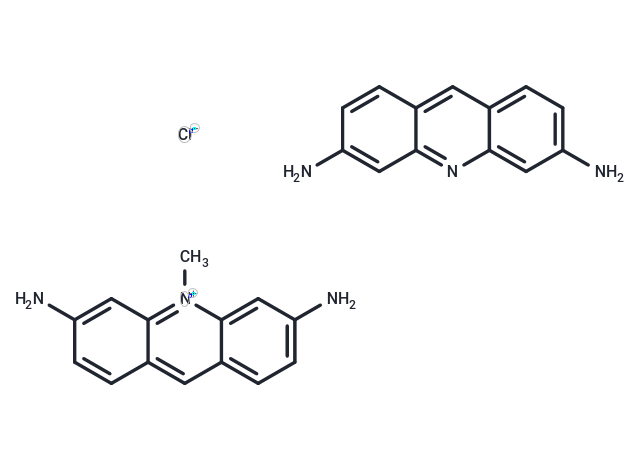Shopping Cart
Remove All Your shopping cart is currently empty
Your shopping cart is currently empty
Acriflavine (Acriflavinium chloride 3,6-Acridinediamine mix) is a papain-like protease (PL(pro)) inhibitor, a fluorescent dye for labeling high molecular weight RNAs, has antimicrobial and anticancer activity, inhibits SARS-CoV-2 and other β-coronaviruses, and can be used for research on leukemia. be used to study leukemia.

| Pack Size | Price | USA Warehouse | Global Warehouse | Quantity |
|---|---|---|---|---|
| 50 mg | $31 | In Stock | In Stock | |
| 100 mg | $44 | In Stock | In Stock | |
| 500 mg | $98 | In Stock | In Stock | |
| 1 g | $148 | In Stock | In Stock |
| Description | Acriflavine (Acriflavinium chloride 3,6-Acridinediamine mix) is a papain-like protease (PL(pro)) inhibitor, a fluorescent dye for labeling high molecular weight RNAs, has antimicrobial and anticancer activity, inhibits SARS-CoV-2 and other β-coronaviruses, and can be used for research on leukemia. be used to study leukemia. |
| In vitro | A novel candidate drug, Acriflavine, exhibits significant dose-dependent inhibition of A549 cell viability at low concentrations (1, 2, 5, and 10 μM)[1]. |
| In vivo | Nude mice bearing xenografts of A549 cells were intraperitoneally injected with 2 mg/kg ACF daily for six weeks. The results indicate that treatment with ACF leads to a reduction in tumor size[1]. |
| Cell Research | 1. RNA marker Experimental steps: 1. Prepare solution: Dissolve Acriflavine in an appropriate solvent, such as DMSO or water, and the concentration is adjusted according to the experimental needs. 2. Label RNA: Add solution (10-100uM) to the RNA sample and incubate for a certain period of time (usually 30 minutes to 1 hour). 3. Fluorescence measurement: Use a fluorescence spectrophotometer or fluorescence microscope to detect the fluorescence signal of RNA and evaluate labeling efficiency. 2. Antibacterial experiments Experimental steps: 1. Dissolve Acriflavine: Dissolve Acriflavine in an appropriate solvent (usually in PBS or water). 2. Treat bacteria: Contact Acriflavine solution at different concentrations with the bacteria to be tested and incubate for a certain period of time. 3. Detection of inhibitory effect: Measure the antibacterial effect by bacterial growth curve or plate counting method. III. Anti-cancer research Experimental steps: 1. Dissolve Acriflavine: Dissolve Acriflavine in an appropriate solvent (such as DMSO). 2. Treat tumor cells: Add different concentrations of Acriflavine solution to cultured tumor cells and incubate for a certain period of time. 3. Cell proliferation detection: Use MTT method, cloning experiments or other cell proliferation detection methods to evaluate the anti-cancer activity of Acriflavine. IV. SARS-CoV-2 inhibition experiment Experimental steps: 1. Dissolve Acriflavine: Prepare Acriflavine solution in an appropriate solvent. 2. Contact with the virus: Add the Acriflavine solution to the virus culture system and contact with SARS-CoV-2 at different concentrations. 3. Viral inhibition detection: Viral replication level is detected by RT-PCR, virus titer experiments or immunofluorescence analysis. 5. Papain-like protease inhibition experiment: Experimental steps: 1. Prepare Acriflavine solution: Dissolve Acriflavine in an appropriate solvent and adjust the concentration. 2. Reaction with enzymes: Add Acriflavine to the reaction system of papain-like protease and incubate. 3. Measuring enzyme activity: Evaluate the inhibitory effect of Acriflavine on enzyme activity by enzyme activity detection methods, such as substrate cleavage experiments. |
| Animal Research | CML mice are treated daily with acriflavine (8 mg/kg) or PBS via intraperitoneal injection, for 10 days starting from day 7 after bone marrow transplantation [2]. |
| Synonyms | Acriflavinium chloride 3,6-Acridinediamine mix |
| Molecular Weight | 468.98 |
| Formula | C27H25ClN6 |
| Cas No. | 8048-52-0 |
| Smiles | [Cl-].Nc1ccc2cc3ccc(N)cc3nc2c1.C[n+]1c2cc(N)ccc2cc2ccc(N)cc12 |
| Relative Density. | 1.0933 g/cm3 (Estimated) |
| Storage | keep away from direct sunlight,keep away from moisture | Powder: -20°C for 3 years | In solvent: -80°C for 1 year | Shipping with blue ice/Shipping at ambient temperature. | |||||||||||||||||||||||||
| Solubility Information | H2O: 20 mg/mL (42.65 mM), Sonication is recommended. | |||||||||||||||||||||||||
Solution Preparation Table | ||||||||||||||||||||||||||
H2O
| ||||||||||||||||||||||||||
| Size | Quantity | Unit Price | Amount | Operation |
|---|

Copyright © 2015-2025 TargetMol Chemicals Inc. All Rights Reserved.